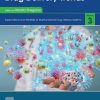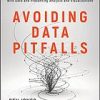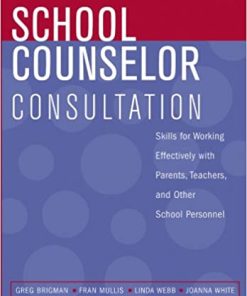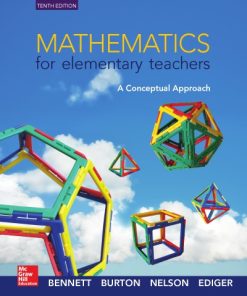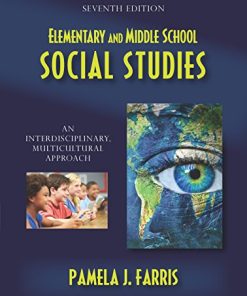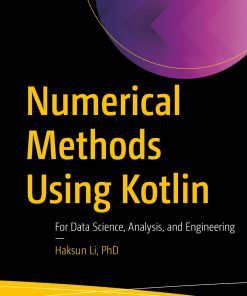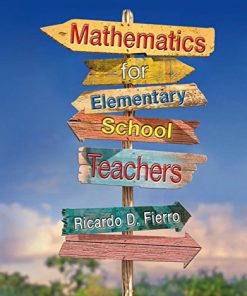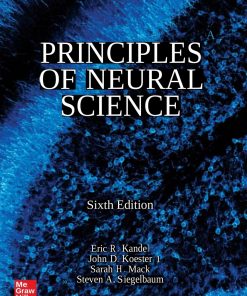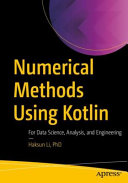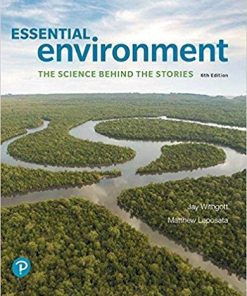Science stories science methods for elementary and middle school teachers 6th Edition by Janice Koch 8214352152 9798214352152
$50.00 Original price was: $50.00.$25.00Current price is: $25.00.
Science stories: science methods for elementary and middle school teachers 6th Edition by Janice Koch – Ebook PDF Instant Download/DeliveryISBN: 8214352152, 9798214352152
Full download Science stories: science methods for elementary and middle school teachers 6th Edition after payment.
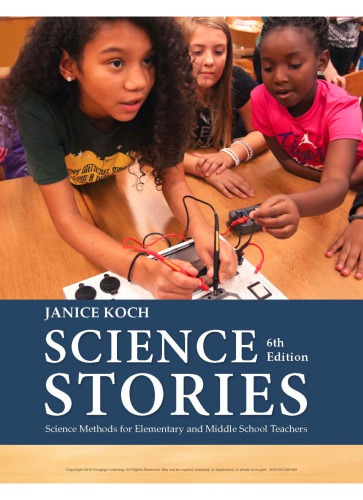
Product details:
ISBN-10 : 8214352152
ISBN-13 : 9798214352152
Author : Janice Koch
SCIENCE STORIES helps preservice and inservice teachers contextualize what it “”looks like”” to engage their students in meaningful science experiences. Using narratives about science teaching and learning in real-world classrooms, this text demonstrates learning, important content, and strategies in action. Author Janice Koch’s approach guides teachers in discovering and exploring their “”scientific selves,”” enabling them to learn from students’ experiences and become effective scientific explorers in their own classrooms. Featuring connections to the Next Generation Science Standards (NGSS), the text empowers teachers to infuse science into their own classrooms by answering such questions as, “Where do I start?” and “How do I use the new standards?” SCIENCE STORIES contains comprehensive chapters on key science disciplinary core ideas, such as life science, physical science, and earth and space science, as well as a chapter that considers student assessment and self-assessment.
Science stories: science methods for elementary and middle school teachers 6th Table of contents:
Part 1. The Scientist Within
Chapter 1. Science Teaching and You: Locating Your Scientific Self
1-1. An Invitation to Teaching Science
1-1a. The Scientist Within
1-2. What Is Science, and Why Teach It?
1-2a. Science as a Set of Practices, a Set of Ideas, and a Way of Thinking about the World
1-2b. The Value of Teaching Science
1-2c. Teaching Science and the STEM Education Movement
1-2d. The Teacher Makes a Difference
1-3. How Do Students Learn Science?
1-3a. Key Tenets of Constructivist Theory
1-3b. Implications for Teaching
1-4. The Diversity of Science Students
1-4a. Questions to Ask about Your Students
1-4b. Connecting Science to All Students
1-5. The Role of Technology in Today’s Science Teaching
1-5a. Simulations and Interactive Websites
1-5b. Tools for Expression
1-5c. A Means of Collaboration
1-6. Locating Your Scientific Self
1-7. Thinking Scientifically
1-8. Beliefs about Science: We Teach Who We Are
1-8a. Your Feelings Show
1-8b. Teacher Attitudes Affect Students’ Attitudes
1-9. Who Is a Scientist? Stereotype versus Reality
1-9a. Drawing a Scientist
1-10. Your Science Autobiography
1-10a. Writing Your Science Autobiography
1-11. Keeping a Science Journal
1-11a. How Do I Keep a Science Journal?
1-11b. A Bird Story: Sample Entries from a Science Journal
1-11c. Some Guidelines for Your Own Science Journal
1-11d. Your Inner Scientist
1-12. Becoming a Science Teacher
Part 2. Doing Science with Students: Inquiry in Practice
Chapter 2. Teachers and Students as Science Learners
2-1. Making Meaning: A Personal Story
2-1a. Helping Students to Make Meaning
2-1b. Prior Knowledge
2-1c. Valuing the Students’ Thinking
2-2. Facilitating Students’ Learning
2-2a. Alternative Conceptions
2-2b. Scaffolding
2-3. Teacher as Mediator
2-4. The Social Context of Teaching and Learning Science: Alternative Conceptions
2-5. Concept Maps and Learning Science
2-6. Students as Knowers
Chapter 3. Engaging Students in Science and Engineering Practices
3-1. Science and Engineering Practices: Using Multistation Activities
3-2. Science Notebooks
3-3. A Science Activity “Circus”
3-4. Technology Extends Our Senses
3-4a. Real-Time Data Collection Software
3-4b. Using Video to Extend Observations
3-5. Science in the Classroom and with the Family
3-5a. Family Science Night
Chapter 4. Scientific Explorations Inside and Outside the Classroom
4-1. Two Types of Science Curricula
4-2. The Importance of Experiences with Nature
4-2a. Diversity Within and Without
4-3. Seeing the Larger Picture: Content Plus Context
4-4. Making Observations of Local Trees: Understanding Common Ancestry
4-5. Scientific Data as Evidence
4-6. Field Trips
4-6a. Tips for Outdoor Science Experiences
4-7. Science Centers: Bringing the Outside Inside the Classroom
4-7a. Making the Science Center an Interactive Experience
4-7b. Sample Science Centers from Around the Country
4-8. The Daily Life of the Classroom
Chapter 5. Exploring Matter: Scientific Observations of Everyday Materials
5-1. Exploring Matter: Scientific Observations of Everyday Materials
5-2. Explorations at Science Stations
5-3. Finding the Right Grouping Is Sometimes Challenging
5-4. If It’s so Messy, Can It Be Science?
5-4a. Messiness in the Classroom
5-4b. Keeping It Complex
Chapter 6. Plants and Animals and Extended Investigations
6-1. What Does It Mean to Be Alive?
6-2. Plants and Animals in Your Science Center
6-3. From Seed to Plant
6-4. Studying Plant Life Cycles in Nature
6-4a. Plant Parts and Plant Function
6-5. A Classroom Invertebrate
6-5a. Observing and Investigating Earthworms
6-5b. Working Together to Conduct Investigations over Time
Chapter 7. Physical Science Explorations: Density and Its Implications
7-1. Floating and Sinking Experiences with Young Students
7-2. Older Students Explore the Differing Density of Liquids
7-3. The Design Challenge of Building Science Toys
7-4. Levels of Understanding: A Further Exploration
7-5. Extending Curriculum: Taking Advantage of Emerging Relevance
7-6. Looking Ahead at Deepening Levels of Understanding
7-7. Using Mathematics and Computational Thinking
7-7a. Deepening of Understandings
Chapter 8. Using Models and Engineering Design for Teaching and Learning Science
8-1. The Usefulness of Models
8-1a. What Do We Mean by a Model?
8-2. An Edible Solar System
8-3. From Models to Meaning
8-4. Shapes of the Moon
8-4a. Using Moon-Phase Journals
8-5. Making Models with Engineering Design
8-6. Engineering Design Technology
8-6a. Design Portfolios
Chapter 9. Beyond the “Science Kit”
9-1. The Electricity Kit
9-2. The Electricity Kit—Revisited
9-3. Applying What They Learned
9-4. Thinking about Teaching and Learning: Science PCK
9-4a. The Learning Cycle Revisited
Part 3. Creating the Science Experience in Your Classroom
Chapter 10. Content and Curriculum: Science Concepts and Your Scientific Self
10-1. Making New Concepts Your Own
10-2. Organizing the Science Curriculum
10-3. Systems
10-4. The Solar System
10-4a. The Sun and the Planets
10-4b. Smaller Objects in the Solar System
10-4c. Gravity and Inertia: Governing Principles of the Solar System
10-5. Human Body Systems
10-5a. The Digestive System
10-5b. The Circulatory System
10-5c. The Respiratory System
10-5d. The Nervous System
10-6. Simple Machines
10-6a. Lever
10-6b. Wheel and Axle
10-6c. Pulley
10-6d. Inclined Plane
10-6e. Wedge
10-6f. Screw
10-6g. Compound Machines and Gears
10-7. The Earth as a Super-System
10-7a. The Earth’s System and Green Science
10-7b. Energy and Matter in the Earth’s System
10-8. Interactions and Patterns of Change
10-8a. Heat Energy and Matter
10-8b. Water
10-8c. Sugar
10-8d. Bottles and Balloons
10-8e. Sources of Heat Energy
10-9. Heat Energy on the Move
10-10. Electricity
10-10a. The Structure of Matter and the Electron
10-10b. Static and Current Electricity
10-10c. Energy Transformations and Generators
10-11. Light
10-11a. Sources of Light
10-11b. Light Energy and Matter
10-11c. Color
10-12. Sound
10-12a. The Speed of Sound
10-12b. Characteristics of Sound
10-12c. The Human Voice
10-13. Magnetism
10-13a. Electromagnets
10-13b. What Causes Magnetism?
10-13c. The Earth as a Magnet
10-14. From Content to Curriculum
10-15. Who Creates the Curriculum? National Influence and Local Control
10-15a. The STEM Education Movement
10-15b. STEM and Group Projects
10-15c. The Impact of STEM
10-16. Developing Curriculum Units
10-16a. Aligning a Unit of Study with the NGSS
10-16b. Selecting Activities
10-16c. What Is Missing?
10-16d. A Checklist for the Science Curriculum
Chapter 11. Surrounded by Science: Science Connections Across Disciplines
11-1. The Importance of Interdisciplinary Connections
11-2. Making Meaning with Dialog Poems
11-3. Mathematics, Measuring, and Meaning Making
11-4. Science and Engineering Design in a Second-Grade Class
11-5. Making the Science and Art History Connection
11-6. STEM Education and More
Chapter 12. Planning for Science: Instructional Strategies
12-1. Encouraging Underrepresented Students in Science
12-2. Teaching Science to English Language Learners (ELLs)
12-3. An Activity Is Not a Lesson
12-4. Planning the Lesson
12-5. A Planning Guide
12-5a. Goals
12-5b. Disciplinary Core Ideas
12-5c. Engage
12-5d. Explore
12-5e. Explain
12-5f. Elaborate
12-5g. Evaluate
12-5h. If I Know It, Do I Have to Write It?
12-5i. Time Allotment
12-6. After the Planning, the Letting Go!
12-7. The Role of Questioning
12-7a. Types of Questions
12-7b. Questions That Invite Students to Action
12-7c. Questions That Access Students’ Own Ideas and Prior Knowledge
12-7d. Questions That Check for Understanding
12-7e. Don’t Rush: A Word about Wait Time
12-8. Science Learning Groups: Creating an Environment for Team Work
12-8a. Learning Groups
12-8b. Small-Group Learning Works
12-8c. Cooperative Learning and Reflection
12-8d. Learning in a Social Context
12-8e. Cultural Diversity and Gender in Cooperative Learning
12-8f. Scientific Investigation and Group Learning
12-9. Structuring Cooperative Learning Groups in Your Classroom
12-9a. Assigning Students to Groups
12-9b. Assigning Group Roles
12-9c. Facilitating Group Learning
12-9d. Cooperative Groups across the Globe
12-10. Inclusive Science Education
12-10a. Science and the Inclusion Model
12-10b. Classroom Strategies for Doing Science with Students with Disabilities
12-11. Technology to Foster the Success of Students with Disabilities
12-12. Questions for Your Own Reflection
Chapter 13. What’s the Big Idea? Assessing for Understanding
13-1. Assessment and Testing
13-2. Formative, Summative, and Performance Assessments
13-3. Assessment and the Instructional Context
13-4. Science Notebooks and Assessment
13-4a. A Sample Structure for a Science Notebook
13-4b. Pictures and Telling Stories
13-4c. Assessing Student Notebooks
13-5. Other Types of Writing Assignments
13-5a. Middle Schoolers Blog about Organelles
13-6. Using Science Conversations for Assessment
13-7. Using Technology to Assess Understanding
13-7a. Concept Maps
13-7b. Electronic Presentations
13-8. Multiple Types of Performances
13-8a. Third Graders Enact the Water Cycle
13-8b. Second Graders Do a Station Assessment for a Unit on Matter
13-9. Assessing, Teaching, and Learning
Chapter 14. Pulling it All Together
14-1. Your Scientific Self
14-2. Developing a Personal Philosophy
14-3. Professional Development
14-3a. Networking in the Profession
14-3b. Promotion and Certification Requirements
14-3c. Further Means of Professional Development
14-4. How Am I Doing? A Guide to Self-Evaluation
14-5. Looking Back to Look Ahead: A New Chapter in Your Science Autobiography
People also search for Science stories: science methods for elementary and middle school teachers 6th:
science topics for elementary students
stem science activities for elementary
stem science activities
science research topics for stem students
science stories science methods
Tags: Science stories, science methods, elementary, middle school teachers, Janice Koch
You may also like…
Uncategorized
Uncategorized
Computers - Programming
Numerical Methods Using Kotlin: For Data Science, Analysis, and Engineering 1st Edition Haksun Li
Medicine - Neurology
Mathematics - Numerical Analysis
Numerical Methods Using Kotlin: For Data Science, Analysis, and Engineering 1st Edition


